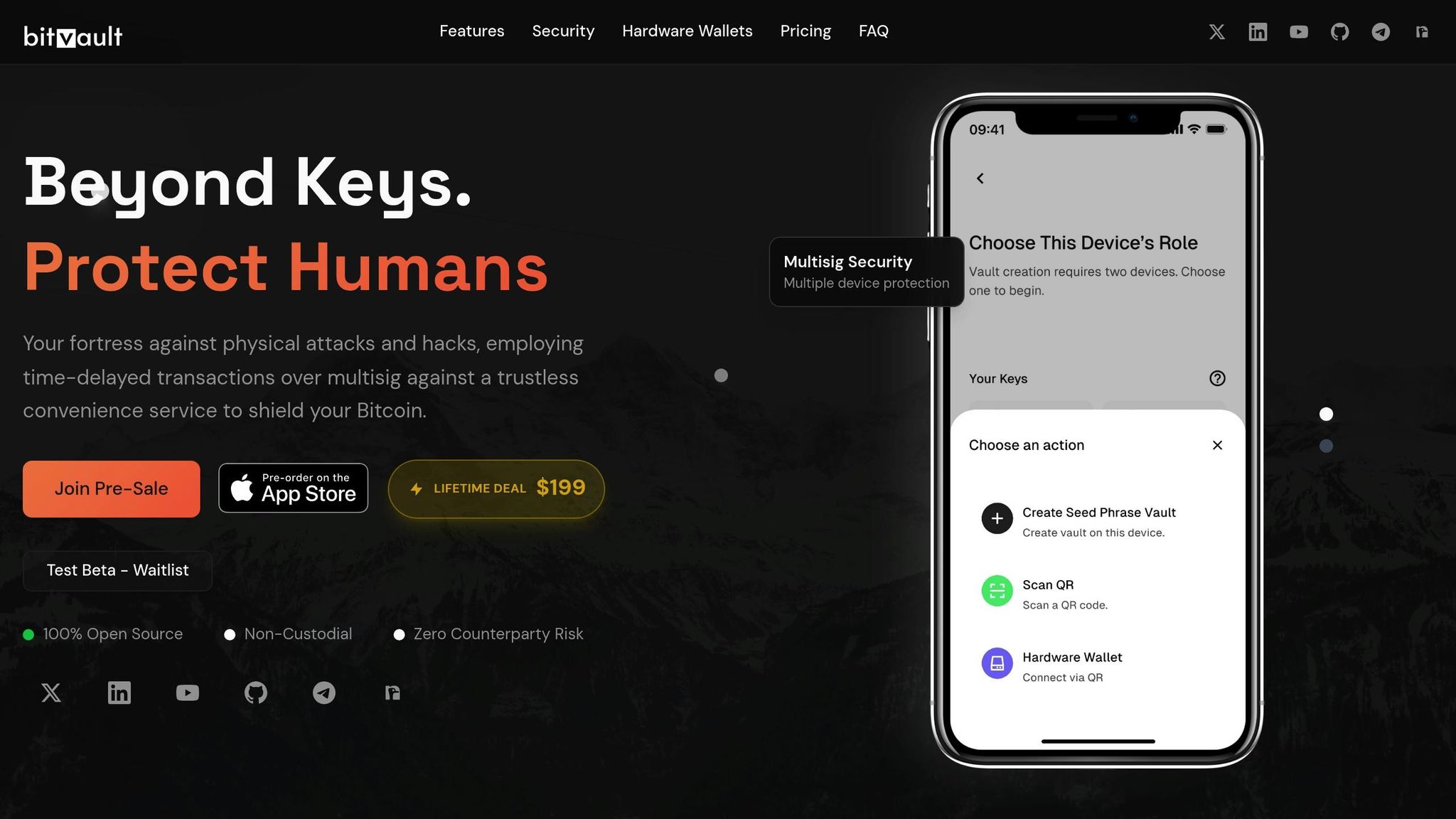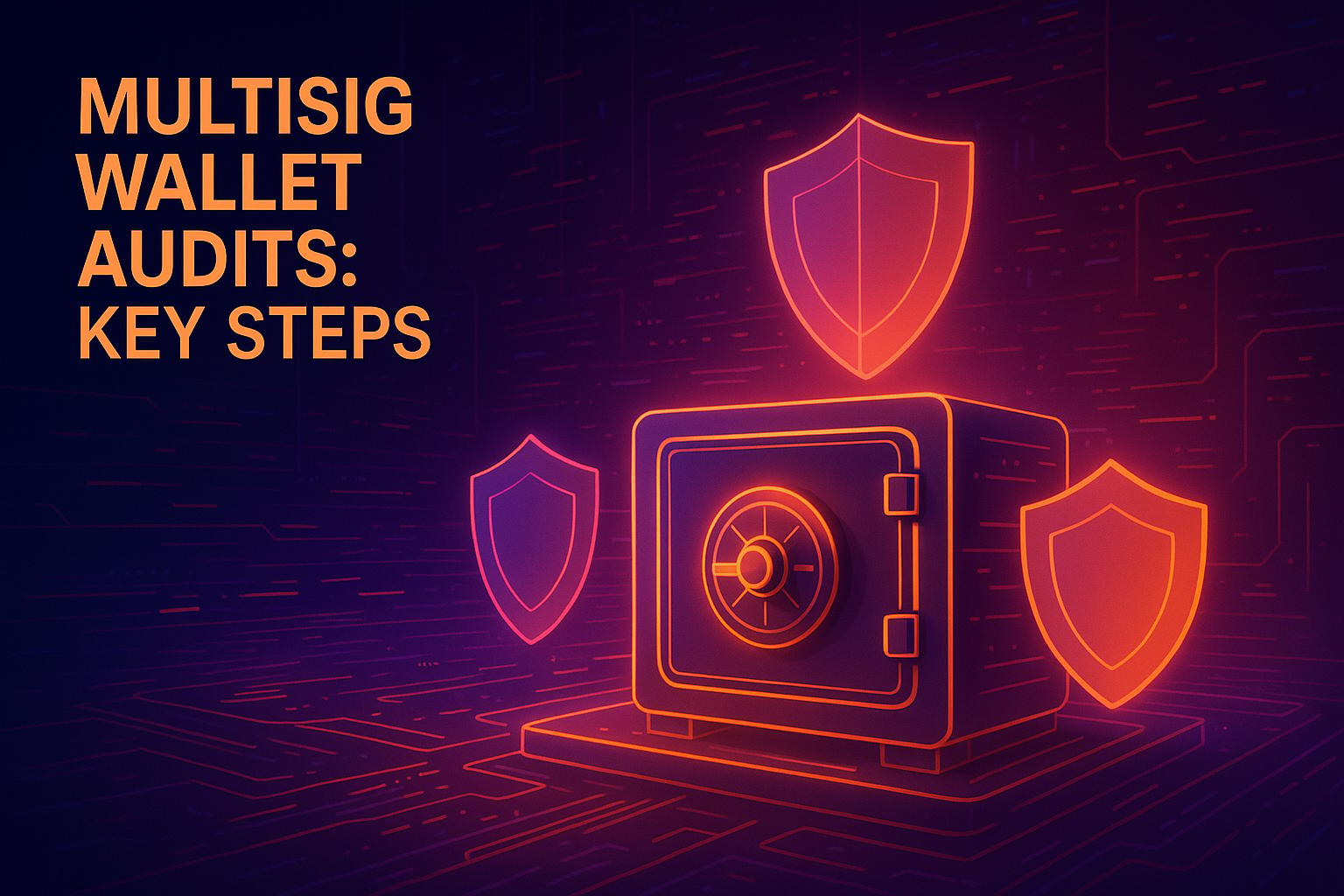When it comes to Bitcoin security, you have two main options: real-time alerts or manual monitoring. Each approach has its strengths and weaknesses, depending on your needs and the size of your Bitcoin holdings.
- Real-Time Alerts: Automated systems notify you instantly about activity on your wallet or addresses. They’re fast, scalable, and reduce the risk of missing threats. However, they require setup and may occasionally trigger false alarms.
- Manual Monitoring: This involves regularly checking your wallet balances and transactions yourself. It’s straightforward and doesn’t rely on technology, but it’s time-consuming, prone to human error, and harder to manage as your Bitcoin activity grows.
For most users, real-time alerts provide faster detection and better scalability, especially for larger holdings. Manual monitoring might work for smaller accounts but can leave gaps in security. A hybrid approach - combining both methods - can offer a balance between speed and oversight.
Here’s a quick comparison:
| Factor | Real-Time Alerts | Manual Monitoring |
|---|---|---|
| Speed of Detection | Instant notifications | Delayed due to periodic checks |
| Accuracy | High, but can trigger false positives | Prone to human error |
| Resource Requirements | Minimal effort after setup | Labor-intensive and time-consuming |
| Scalability | Handles high activity easily | Limited by human capacity |
| Cost | Higher upfront, lower ongoing costs | Lower upfront, higher ongoing effort |
If your Bitcoin security is a priority, consider using tools like BitVault, which combines real-time alerts with advanced safeguards like time-delayed transactions and multisig protection. These features give you more control and time to respond to potential threats.
How To Use Security Monitoring In Blockchain? - CryptoBasics360.com
Real-Time Security Alerts: How They Work
Real-time security alerts are automated tools that keep a constant watch over the Bitcoin blockchain and your specific wallet addresses, ensuring you're immediately informed of any activity. Think of them as 24/7 guardians for your Bitcoin, ready to notify you the moment something happens.
These systems operate by connecting to Bitcoin nodes or blockchain APIs to monitor transactions in real time. If a transaction involves one of your monitored addresses, the system processes the data and sends you an alert through your chosen method - email, SMS, push notifications, or even secure messaging apps.
This kind of automation is crucial for those who rely on self-custody to secure their Bitcoin. Quick alerts can be the difference between spotting an issue early and suffering a loss. Let’s break down how these systems deliver such rapid notifications.
Key Features of Real-Time Alerts
These systems are packed with features designed to ensure you receive timely and accurate alerts:
- Instant notifications: As soon as a transaction involving your Bitcoin address is broadcast to the blockchain, you’re notified. Typically, this happens within 1 to 10 minutes of the transaction being detected on the network.
- Customizable monitoring options: You can tailor the system to alert you based on specific triggers. For example, you might set it to notify you of transactions exceeding a certain amount, during unusual hours, or involving specific addresses.
- Multi-channel delivery: Alerts are sent through multiple channels - email, SMS, app notifications, or webhooks - so you’re always connected. This redundancy ensures you never miss critical updates.
- Seamless blockchain integration: These systems directly connect to Bitcoin’s network, accessing multiple nodes to verify transaction data and reduce the chances of false positives.
Benefits of Real-Time Alerts
Real-time alerts give you the ability to respond to potential threats quickly, eliminating the need for constant manual monitoring. If someone tries to move your Bitcoin without permission, you’ll know within minutes, giving you time to act - especially if you use advanced security measures like time-delayed transactions or multisig setups.
Another major advantage is peace of mind. Whether you’re asleep, traveling, or just busy, you can trust that any Bitcoin-related activity will immediately come to your attention. This reassurance is invaluable in the high-pressure world of cryptocurrency security.
Use Cases for Real-Time Alerts
Real-time alerts aren’t just a convenience - they’re a powerful tool for managing and securing your Bitcoin. Here are some practical scenarios where they shine:
- Unauthorized transaction detection: If someone gains access to your wallet or private keys and attempts to steal your Bitcoin, an alert will notify you right away. This is especially critical for large holdings, where even small delays can lead to significant losses.
- Monitoring wallet activity: Keep track of all incoming and outgoing transactions across multiple addresses. This is particularly helpful for businesses, fund managers, or anyone who wants a clear record of their Bitcoin activity.
- Preventing security breaches: Alerts can help you spot unusual activity, such as unauthorized access attempts or probing of your wallet’s defenses. This early warning allows you to investigate and strengthen your security before an attack succeeds.
- Managing multiple wallets: If you use several wallets for different purposes, centralized alerts make it easy to monitor them all without manually checking each one. This is especially useful for those with complex setups involving various address types.
- Confirming time-sensitive transactions: Whether you’re making a large purchase, sending funds to an exchange, or handling a business payment, real-time alerts confirm that your Bitcoin has been successfully sent and received.
Real-time security alerts are more than just notifications - they’re a critical layer of protection, giving you the tools to stay informed and in control of your Bitcoin at all times.
Manual Monitoring: Processes and Challenges
Managing Bitcoin self-custody requires a hands-on approach to security, and manual monitoring remains a traditional, though demanding, method. It relies entirely on your vigilance to regularly check wallets and transactions.
While this approach may suit some users, its drawbacks become evident as your Bitcoin holdings grow or your security needs expand.
Typical Manual Monitoring Processes
Manual monitoring involves a series of routine tasks that Bitcoin holders must consistently perform to stay on top of security. These tasks include checking wallet balances daily, reviewing transaction logs for irregularities, verifying balances against expected amounts, conducting periodic security audits, and using blockchain explorers to track address activity.
Balance verification is a key part of this process. It involves comparing your wallet's current balances with what you expect based on recent transactions. Many users rely on spreadsheets or handwritten logs to track their Bitcoin across multiple addresses and wallets. However, as transaction volumes increase, this manual tracking becomes more cumbersome and prone to errors.
Security audits are another critical step. These audits might include reviewing wallet security settings, ensuring software is up to date, and confirming that backup phrases and private keys are safely stored. You may also need to test wallet recovery procedures or verify that multisig configurations are functioning as intended.
Address monitoring requires manually checking transaction activity for specific Bitcoin addresses. This often involves copying and pasting addresses into blockchain explorers like Blockchain.info or Blockstream.info to review transaction histories for any signs of suspicious activity. Although these steps are essential for maintaining security, they come with several challenges.
Challenges of Manual Monitoring
Manual monitoring introduces delays in detecting threats, increases the likelihood of human error, and becomes unmanageable as your Bitcoin activity scales up. Unlike automated systems that provide immediate alerts for unusual activity, manual monitoring might take hours, days, or even weeks to uncover issues.
Human error and oversight are significant risks. When reviewing transaction logs, it’s easy to miss critical details, particularly if you’re tired, distracted, or dealing with a high volume of transactions. Small unauthorized transactions, misread addresses, or gradual balance changes can all slip through unnoticed.
Time and effort demands make manual monitoring a time-intensive process. Checking multiple wallets daily can take 30 to 60 minutes, and this commitment becomes harder to sustain during busy periods, travel, or unforeseen emergencies.
Inconsistent monitoring schedules often arise as users struggle to maintain regular habits. You might be diligent for weeks but then skip several days due to other priorities, creating gaps where potential threats go undetected.
Limited technical expertise can also hinder effective monitoring. Without a solid understanding of transaction details, users might misinterpret what they see, failing to recognize subtle warning signs that could indicate security issues.
Scalability challenges become increasingly evident as users manage more Bitcoin addresses, use multiple wallets, or engage in frequent transactions. Monitoring one address manually might be manageable, but tracking dozens of addresses across various wallet types quickly becomes overwhelming, highlighting the need to explore alternative monitoring methods.
sbb-itb-c977069
Real-Time Alerts vs Manual Monitoring Comparison
Let’s break down how real-time alerts and manual monitoring stack up in terms of speed, accuracy, resource use, scalability, threat detection, and cost.
Comparison Table
Here’s a quick look at the differences between the two approaches:
| Factor | Real-Time Alerts | Manual Monitoring |
|---|---|---|
| Speed of Detection | Instant notifications as soon as threats occur [2] | Detection is delayed due to periodic review schedules [5] |
| Accuracy | High precision using AI-driven pattern analysis [1] | Susceptible to human error [3] |
| Resource Requirements | Largely automated with minimal ongoing human labor [2] | Labor-intensive and reliant on skilled personnel [5] |
| Scalability | Can efficiently process thousands of transactions per second [2] | Limited by human capacity [5] |
| Threat Detection | Effective at flagging fraud, compliance issues, and rapid attacks [4] | Relies on contextual analysis and human judgment [5] |
| Cost Structure | Higher upfront investment with lower ongoing costs [2] | Lower initial costs but higher long-term staffing expenses [5] |
This table highlights the core advantages and challenges of each method.
Strengths and Weaknesses Analysis
Real-time alert systems shine in speed and automation, making them indispensable in today’s fast-paced threat environment. With $2.2 billion stolen from the crypto space in 2024 - up from $1.8 billion in 2023 [5] - the ability to detect and respond to threats instantly has never been more critical. These systems use customizable rules to flag suspicious activity as it happens, offering a proactive approach to security.
The biggest strength of real-time alerts is their immediacy. When suspicious activity occurs, every second matters. For example, real-time systems can monitor every new block on the Bitcoin blockchain, analyzing input and output addresses to assess risks and detect fraud [1]. Early detection could have mitigated the impact of incidents like the 2022 Ronin Bridge hack, where $625 million was stolen [4].
However, these systems aren’t flawless. Poor configuration can lead to false positives, and they might miss entirely new attack methods that don’t fit existing patterns [3]. Their success depends on proper setup and regular updates to the rule engines.
Manual monitoring, on the other hand, benefits from human intuition and contextual understanding. Skilled reviewers can spot subtle anomalies that automated systems might overlook, making this approach valuable for complex investigations [3]. For cases requiring a deeper dive, human oversight provides nuanced insights that machines can’t replicate.
But manual monitoring comes with its own set of challenges. It’s labor-intensive, prone to human error, and struggles to keep up with large-scale operations [5]. Unlike automated systems, manual processes require constant attention and a growing team as transaction volumes increase.
The resource demands also differ significantly. Real-time systems require a higher upfront investment for technology and integration but drastically reduce the need for ongoing human involvement [2]. Manual monitoring may seem cost-effective initially, but as the need for skilled personnel grows, so do the expenses [5].
For most Bitcoin holders, real-time alerts offer stronger protection. The crypto industry’s increasing reliance on AI-powered monitoring highlights the efficiency and scalability of automation in combating fraud and meeting compliance requirements. Meanwhile, manual monitoring remains a valuable tool for audits and handling particularly intricate investigations.
How BitVault Improves Bitcoin Security

BitVault takes Bitcoin security to the next level by combining real-time alerts with advanced protection measures. Unlike traditional wallets that rely solely on passwords or private keys, BitVault introduces a time-delay multisig architecture to prevent unauthorized transactions. This approach not only enhances security but also addresses the limitations of manual monitoring and standard alerts, creating a more reliable system for safeguarding your assets.
Using Real-Time Alerts with BitVault
BitVault redefines alert systems by integrating secret notifications for immediate threat detection. By linking your Telegram handle to your BitVault wallet, you can receive instant emergency alerts without needing to constantly monitor your account. This feature ensures you're always one step ahead of potential threats.
Time-Delayed Transactions and Multisig Protection
A standout feature of BitVault is its custom time-delay mechanism, which fundamentally changes how Bitcoin transactions are managed. When a transaction is initiated - whether by you or a potential attacker - it enters a waiting period that you set in advance. This delay gives you critical time to verify the transaction or notify trusted contacts if something seems off.
"BitVault exists to change that. It introduces a time-delay mechanism - something that slows down forced withdrawals, giving users time to respond, think, or alert trusted contacts."
- RankPlan [6]
Additionally, BitVault’s multisig architecture requires multiple approvals for transactions. This means that even if one layer of security is compromised, funds cannot be moved without additional approvals. Traditional safeguards like PINs, FaceID, and cross-device two-factor authentication further strengthen the wallet’s defenses.
Bitcoin L2 Integration
BitVault doesn’t stop at security - it also integrates with Bitcoin Layer 2 solutions to improve transaction efficiency. This means you can enjoy the advanced protection of time-delay and multisig features for long-term storage, while using the Lightning Network for faster, low-cost transactions. On top of that, L1 fee optimization helps manage costs during periods of high network congestion, ensuring a smoother experience.
BitVault’s design prioritizes simplicity and control, empowering you to protect your Bitcoin holdings with confidence and ease.
Choosing the Right Monitoring Approach
Deciding between real-time alerts and manual monitoring boils down to your risk tolerance, level of expertise, and the size of your Bitcoin holdings. Each method serves different needs, and knowing when to use them can make a big difference in your overall security strategy.
If your Bitcoin holdings are on the smaller side, manual monitoring can be a practical and budget-friendly option. This approach works well for those who don’t mind setting aside a few minutes each day to keep an eye on their accounts. It’s a great fit for users who value having full control over their security measures.
On the other hand, real-time alerts are indispensable for larger holdings or when immediate threat detection is critical. When the stakes are high, even a brief delay in spotting suspicious activity could lead to serious consequences. Real-time monitoring is especially useful for people who travel often, work in fast-paced environments, or simply want around-the-clock protection without the hassle of manual checks.
A hybrid approach - combining automated alerts with periodic manual reviews - can offer the best of both worlds. It provides the speed of real-time detection alongside the thoroughness of human oversight.
BitVault takes this concept further by integrating both methods to bolster Bitcoin security. It addresses the shortcomings of traditional approaches, particularly when it comes to response time. While manual monitoring might miss threats for hours or even days, and some real-time systems might not allow enough time to act, BitVault bridges these gaps. It enables users to verify transactions, respond to threats, or alert trusted contacts before any irreversible actions take place.
For most Bitcoin users, the choice isn’t just about picking between manual monitoring and real-time alerts. It’s about embracing a more advanced solution - one that blends automation with complete control over your funds, ensuring both speed and security.
FAQs
How can real-time alerts and manual monitoring work together to improve Bitcoin security?
Real-time alerts deliver instant notifications about any suspicious activity, enabling you to act swiftly and reduce potential risks. Think of these alerts as your early warning system, cutting down the time it takes for threats to develop into bigger problems.
On the other hand, manual monitoring brings a human touch to security. By diving deep into complex patterns and behaviors, this method can uncover subtle threats that automated systems might overlook. It also helps filter out false alarms, providing more precise insights.
When combined, these two approaches form a well-rounded security plan: real-time alerts keep you ready to respond immediately, while manual monitoring ensures decisions are accurate and well-informed - offering strong protection for your Bitcoin assets.
What are the risks of relying only on real-time alerts for Bitcoin security?
Relying solely on real-time alerts for Bitcoin security can be a risky approach. While alerts can be helpful, depending on them too much might lead users to neglect other critical security measures, like managing private keys securely or performing regular system audits. If the alert system malfunctions or gets compromised, your assets could be left vulnerable.
Real-time alerts also have limitations. They might produce false alarms or fail to detect sophisticated, subtle threats. Plus, they can't address deeper issues like network vulnerabilities or physical security concerns. To protect your Bitcoin effectively, it’s important to pair real-time alerts with additional safeguards, such as multisignature wallets, time-delayed transactions, and proactive monitoring strategies. Together, these measures create a stronger, more reliable defense.
How do BitVault's time-delay and multisig features improve Bitcoin transaction security?
BitVault’s time-delay mechanism works like a high-tech safety lock for your Bitcoin transactions. It lets you set a delay - anywhere from a few hours to several days - on outgoing transfers. This delay gives you a crucial opportunity to review the transaction and stop it if anything seems suspicious or unauthorized.
On top of that, the multisig protection feature requires multiple signatures to approve a transaction. Even if one key is compromised, a hacker won’t be able to access your funds without the other required signatures. These two layers of protection combine to make your Bitcoin transactions far more secure and resistant to theft or cyberattacks.




